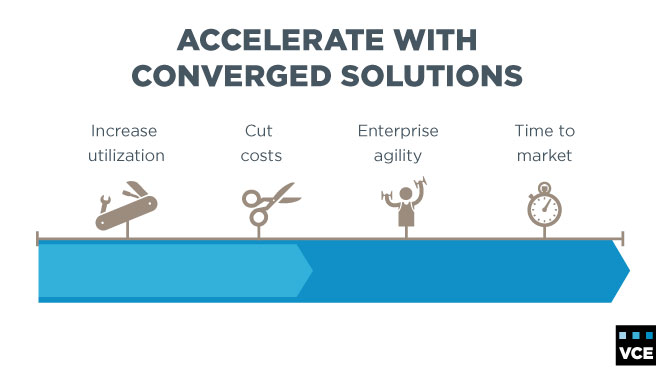The IT industry is in the midst of tremendous change. To meet the evolving requirements of our customers, we have to provide an entire spectrum of IT solutions, from reference architectures to engineered and hyper-converged systems. The focus and conversation also has shifted from a pure IT orientation to the ability to support companies in achieving their business outcomes.
While the term “operational simplicity” has been around for many years, it is finally coming into its own in relation to how IT can be more efficient and effective.  Today’s IT infrastructure has to be more flexible, scalable, and adaptable. An IDC study found that organizations leveraging converged infrastructure were able to develop 4.6x more apps and get products to market 4.4x faster.
Today’s IT infrastructure has to be more flexible, scalable, and adaptable. An IDC study found that organizations leveraging converged infrastructure were able to develop 4.6x more apps and get products to market 4.4x faster.
Using converged infrastructure means IT staffs need less effort to manage their servers, storage and networking workloads. They can also save time in having to manage patching and software updates, not to mention experience less downtime.
Here are a few other suggestions for achieving more operational simplicity:
It’s all about the apps
We have fully entered the age of the app, and it is time that IT recognized apps are what drives the business toward greater profitability and growth. IT plays a key role here. How quickly apps are deployed can make or break a new product or service launch.
The amount of time it takes to maintain apps can be critical. We should be agile enough to introduce new versions without getting bogged down trying to figure out requirements. IT also needs to be more responsive to end user requests to create new apps, making it easier to add apps to the overall corporate portfolio.
Provision on-demand workloads efficiently
Efficient provisioning is possible through automated management tools. While virtualized systems are helpful, they lose their benefit if virtual instances have to be manually brought up and torn down. Look toward orchestration and automation services that can do this automatically, and understand the variations in specific workload demands. It shouldn’t be a chore to bring up new virtual machines or to clone existing servers.
Enable infrastructure to scale up and down easily
Part of understanding automated provisioning is knowing the consequences of how specific infrastructure actually operates at scale. A good exercise in understanding business agility is to pretest critical infrastructure to make sure it can scale when needed. Retail businesses do this to handle the extra load at holiday time when people stay home and shop online.
Become a listener
In leveraging converged infrastructure to automate provisioning, it’s important that we keep end user needs in mind. The more we listen to our end users, the better chance we’ll have of understanding their perspective and designing systems that are meaningful and deliver what they need.
Automate common IT tasks to free up staff time
Does your staff spend time tending to backups, upgrading software versions, and tracking down connectivity issues? Chances are we all have some of these issues, but the goal should be to apply automation to eliminate as much drudgery as possible.
Each of these is a great start toward operational simplicity. It is hard work to become simpler, but it ultimately pays off when our IT teams enable greater success across the enterprise.